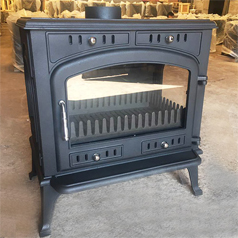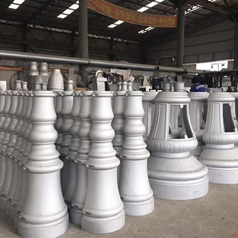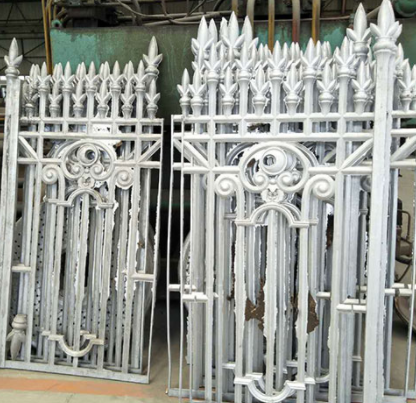Iron castings generally refer to objects cast with iron. Is the most commonly used metal.
Numerical simulation of temperature field of solidification process of thick section ductile iron casting was carried out by computer. Increasing the strength of the mold shell, the firing temperature, and lowering the pouring temperature are conducive to reducing the reject rate of castings and improving the quality of ductile iron castings.
Key casting process and application of high-quality machine tool ductile iron castings
Comprehensively analyze the structure and key casting process of NC machine ductile iron pillars. According to the uneven wall thickness, the solidification order of the outer part and the central part of the thick part is very different, and it is easy to produce shrinkage, shrinkage and high internal quality requirements. For a series of problems, a semi-closed bottom-injection system is used, and technical measures such as cold iron and overflow are added to effectively prevent defects such as shrinkage and shrinkage of castings. Produced qualified ductile iron castings, accumulated rich experience for the production of high-quality machine tool ductile iron castings.
Structural analysis and technical requirements for iron casting foundry:
For CNC machine tool parts, the maximum contour size is 2296mm × 1598. 5mm × 672mm, there are 3 guide rails, the wall thickness is thick, the average wall thickness is 35mm, and the thickest part is 78mm. Mechanical performance requirements.
The iron casting flower pot supplier believes that the quality of castings is very high. It not only requires mechanical properties, but also has strict regulations on casting defects and appearance quality. The casting requires ultrasonic inspection and magnetic particle inspection, and welding defects are not allowed to be repaired; the flatness, straightness, and parallelism of the guide rail surface are within 5mm; the dimensional tolerance of the casting must conform to the standard ISO 8062-CT11 level; the maximum blank weight of the casting is 3266kg; The casting must remain in the sand mold until the casting temperature is below 280 ° C, and no treatment is allowed on the casting until the casting has cooled to room temperature.
Difficulty analysis of casting process
1. The casting structure is designed as an A-shaped structure, with feet at both ends. In order to fasten the bolts at the feet, the outer skin is thicker, which may cause shrinkage and insufficient pouring.
2. The casting material is nodular cast iron. The solidification method of ductile iron is pasty solidification. The eutectic solidification time is long. The solidification order of the thick and thin parts is different from the central part. Adjusting the solidification speed and the temperature gradient of the casting at the thick and hot joints have a certain effect on the shrinkage of the casting.
3. Through the casting structure and material, the process adopts a semi-closed bottom-injection casting system. Due to the uneven wall thickness of the casting and the longer rail size, a supplementary shrinkage system combining open and cold iron and overflow is designed to ensure the casting There are no defects such as shrinkage and shrinkage in key parts. No treatment of the casting is allowed until the casting has cooled to room temperature.

Iron Casting Design
Determination of pouring position and parting surface
After research and analysis, considering the iron casting design and technical requirements, and combining with the actual production conditions, the casting follows the principle of sequential solidification. The flat casting method and the upper and lower two box modeling method are used. The guide surface of the column is the key surface. Defects such as trachoma, pores, slag holes, cracks, and shrinkage are allowed, and the structure must be dense and uniform to ensure that the hardness value is within the specified range. Although the guide surface is relatively thick, for ductile iron parts, the best pouring position of the column is that the guide surface is facing down, and the parting surface is selected on a larger plane.
Selection of process parameters
1. Casting shrinkage: It is affected by many factors, such as the composition and type of alloy, the cooling of castings, the resistance to shrinkage, the difference in cooling conditions, etc. Therefore, it is very difficult to accurately calculate the casting shrinkage. Through marking the mass-produced casting several times, the actual shrinkage of each part of the casting was measured, the data was repeatedly verified and summarized, and finally the shrinkage of the casting was selected to be 1%.
2. Machining allowances: In order to ensure the size of the machined surface and the accuracy of the parts, the machining allowances should have machining allowances. The factors that affect them include: the type of casting material, the casting process, the production batch, the level of equipment and tooling, etc. The contour size is relatively large, and the size requirements are strict. The tolerance of casting dimensions conforms to the requirements of the standard ISO 8062-CT11 grade. The machining allowance of the key surface of the guide rail is 10mm, and the machining tolerances of the other dimensions adopt ISO 8062-CT11 grade tolerance.
3. Negative parting number: select 2mm, put them in the lower case, the rest is not noted with a gap of 2mm, the unmarked draft is inclined 0 / + 2mm, the internal ribs are inclined slightly unilaterally by -2 / + 3mm, and the ends of the ends of the guide rail are corresponding Increase the process correction amount by +3 mm.
 How To Solve The Burr Of Aluminum Castings
Jul. 29, 2024
How To Solve The Burr Of Aluminum Castings
Jul. 29, 2024
 Aluminum Casting 4 Kinds Of The Surface Treatment Pr...
Jul. 09, 2024
Aluminum Casting 4 Kinds Of The Surface Treatment Pr...
Jul. 09, 2024
Copyright © Dalian Lianjiang Metal Co., Ltd. All Rights Reserved | Sitemap
Recommend Products: Aluminum Mailbox With Post
